Assessing Meteorological and Agricultural Drought in Chitral Kabul River Basin Using Multiple Drought Indices
Abstract
1. Introduction
2. Materials and Methods
2.1. Study Area
2.2. Remote Sensing Data
2.3. Meteorological Stations Data
2.4. Data Processing
3. Data Validation
3.1. Correlation of PMD and CHIRPS’ Precipitation
3.2. Correlation of PMD and NEX_GDDP Precipitation
4. Results and Discussion
4.1. Meteorological Drought
4.2. Agricultural Drought
4.3. Comparison of Modeled Derived PCI with SPI-3 and PCI Calculated from Rain Gauge Station Data
4.4. Future Drought Projections
5. Conclusions
Author Contributions
Funding
Acknowledgments
Conflicts of Interest
References
- Liu, Y.; Wang, X.; Guo, M.; Tani, H.; Matsuoka, N.; Matsumura, S. Spatial and Temporal Relationships among NDVI, Climate Factors, and Land Cover Changes in Northeast Asia from 1982 to 2009. GISci. Remote Sens. 2011, 48, 371–393. [Google Scholar] [CrossRef]
- Ahmad, F. Detection of change in vegetation cover using multi-spectral and multi-temporal information for district Sargodha, Pakistan. Soc. Nat. 2012, 24, 557–571. [Google Scholar] [CrossRef]
- Jiao, W.; Zhang, L.; Chang, Q.; Fu, D.; Cen, Y.; Tong, Q. Evaluating an Enhanced Vegetation Condition Index (VCI) Based on VIUPD for Drought Monitoring in the Continental United States. Remote Sens. 2016, 8, 224. [Google Scholar] [CrossRef]
- Wu, J.; He, B.; Lü, A.; Zhou, L.; Liu, M.; Zhao, L. Quantitative assessment and spatial characteristics analysis of agricultural drought vulnerability in China. Nat. Hazards 2010, 56, 785–801. [Google Scholar] [CrossRef]
- Dai, A. Increasing drought under global warming in observations and models. Nat. Clim. Chang. 2012, 3, 52–58. [Google Scholar] [CrossRef]
- Zhang, L.; Jiao, W.; Zhang, H.; Huang, C.; Tong, Q. Studying drought phenomena in the Continental United States in 2011 and 2012 using various drought indices. Remote Sens. Environ. 2017, 190, 96–106. [Google Scholar] [CrossRef]
- Sawada, Y.; Koike, T. Ecosystem resilience to the Millennium drought in southeast Australia (2001–2009). J. Geophys. Res. Biogeosci. 2016, 121, 2312–2327. [Google Scholar] [CrossRef]
- Ahmadi, B.; Ahmadalipour, A.; Moradkhani, H. Hydrological drought persistence and recovery over the CONUS: A multi-stage framework considering water quantity and quality. Water Res. 2019, 150, 97–110. [Google Scholar] [CrossRef]
- Parry, S.; Prudhomme, C.; Wilby, R.L.; Wood, P.J. Drought termination. Prog. Phys. Geogr. Earth Environ. 2016, 40, 743–767. [Google Scholar] [CrossRef]
- Dracup, J.A.; Lee, K.S.; Paulson, E.G. On the statistical characteristics of drought events. Water Resour. Res. 1980, 16, 289–296. [Google Scholar] [CrossRef]
- Egeru, A.; Barasa, B.; Nampijja, J.; Siya, A.; Makooma, M.T.; Majaliwa, M.G.J. Past, Present and Future Climate Trends Under Varied Representative Concentration Pathways for a Sub-Humid Region in Uganda. Climate 2019, 7, 35. [Google Scholar] [CrossRef]
- Makokha, G.O.; Wang, L.; Zhou, J.; Li, X.; Wang, A.; Wang, G.; Kuria, D. Quantitative drought monitoring in a typical cold river basin over Tibetan Plateau: An integration of meteorological, agricultural and hydrological droughts. J. Hydrol. 2016, 543, 782–795. [Google Scholar] [CrossRef]
- Yan, N.; Wu, B.; Boken, V.K.; Chang, S.; Yang, L. A drought monitoring operational system for China using satellite data: Design and evaluation. Geomat. Nat. Hazards Risk 2014, 7, 264–277. [Google Scholar] [CrossRef]
- Ebaid, H.M. Real time drought monitoring using Remote Sensing approaches A Case Study: Western desert of Kharga and Dakhla Regions. Int. J. Geomat. Geosci. 2016, 6, 1638–1652. [Google Scholar]
- Himanshu, S.; Singh, G.; Kharola, N. Monitoring of drought using satellite data. Int. Res. J. Earth Sci. 2015, 3, 66–72. [Google Scholar]
- Yaduvanshi, A.; Srivastava, P.K.; Pandey, A.C. Integrating TRMM and MODIS satellite with socio-economic vulnerability for monitoring drought risk over a tropical region of India. Phys. Chem. Earth Parts A/B/C 2015, 83–84, 14–27. [Google Scholar] [CrossRef]
- Sholihah, R.I.; Trisasongko, B.H.; Shiddiq, D.; La Ode, S.I.; Kusdaryanto, S.; Panuju, D.R. Identification of Agricultural Drought Extent Based on Vegetation Health Indices of Landsat Data: Case of Subang and Karawang, Indonesia. Procedia Environ. Sci. 2016, 33, 14–20. [Google Scholar] [CrossRef]
- Cai, G.; Du, M.; Liu, Y. Regional Drought Monitoring and Analyzing Using MODIS Data—A Case Study in Yunnan Province. In Computer and Computing Technologies in Agriculture IV; Springer: Berlin/Heidelberg, Germany, 2011; pp. 243–251. [Google Scholar] [CrossRef]
- AghaKouchak, A.; Farahmand, A.; Melton, F.S.; Teixeira, J.; Anderson, M.C.; Wardlow, B.D.; Hain, C.R. Remote sensing of drought: Progress, challenges and opportunities. Rev. Geophys. 2015, 53, 452–480. [Google Scholar] [CrossRef]
- McKee, T.B.; Doesken, N.J.; Kleist, J. The relationship of drought frequency and duration to time scales. In Proceedings of the 8th Conference on Applied Climatology, Anaheim, CA, USA, 17–22 January 1993; pp. 179–183. [Google Scholar]
- Xu, X.; Xie, F.; Zhou, X. Research on spatial and temporal characteristics of drought based on GIS using Remote Sensing Big Data. Clust. Comput. 2016, 19, 757–767. [Google Scholar] [CrossRef]
- Kogan, F.N. Application of vegetation index and brightness temperature for drought detection. Adv. Space Res. 1995, 15, 91–100. [Google Scholar] [CrossRef]
- Dutta, D.; Kundu, A.; Patel, N.R.; Saha, S.K.; Siddiqui, A.R. Assessment of agricultural drought in Rajasthan (India) using remote sensing derived Vegetation Condition Index (VCI) and Standardized Precipitation Index (SPI). Egypt. J. Remote Sens. Space Sci. 2015, 18, 53–63. [Google Scholar] [CrossRef]
- Zhang, J.; Mu, Q.; Huang, J. Assessing the remotely sensed Drought Severity Index for agricultural drought monitoring and impact analysis in North China. Ecol. Indic. 2016, 63, 296–309. [Google Scholar] [CrossRef]
- Kogan, F.N. Global Drought Watch from Space. Bull. Am. Meteorol. Soc. 1997, 78, 621–636. [Google Scholar] [CrossRef]
- Zhang, A.; Jia, G. Monitoring meteorological drought in semiarid regions using multi-sensor microwave remote sensing data. Remote Sens. Environ. 2013, 134, 12–23. [Google Scholar] [CrossRef]
- Jiao, W.; Wang, L.; Novick, K.A.; Chang, Q. A new station-enabled multi-sensor integrated index for drought monitoring. J. Hydrol. 2019, 574, 169–180. [Google Scholar] [CrossRef]
- Jiao, W.; Tian, C.; Chang, Q.; Novick, K.A.; Wang, L. A new multi-sensor integrated index for drought monitoring. Agric. For. Meteorol. 2019, 268, 74–85. [Google Scholar] [CrossRef]
- Rhee, J.; Im, J.; Carbone, G.J. Monitoring agricultural drought for arid and humid regions using multi-sensor remote sensing data. Remote Sens. Environ. 2010, 114, 2875–2887. [Google Scholar] [CrossRef]
- Chandrasekar, K.; Sneha, L.; Ramana, K.V.; Rao, P.V.N. Monitoring of Agricultural Drought using Satellite based Drought Severity Index over Andhra Pradesh State of India. Int. J. Adv. Remote Sens. GIS 2017, 6, 2343–2359. [Google Scholar] [CrossRef]
- Törnros, T.; Menzel, L. Addressing drought conditions under current and future climates in the Jordan River region. Hydrol. Earth Syst. Sci. 2014, 18, 305–318. [Google Scholar] [CrossRef]
- Kamali, B.; Houshmand Kouchi, D.; Yang, H.; Abbaspour, K. Multilevel Drought Hazard Assessment under Climate Change Scenarios in Semi-Arid Regions—A Case Study of the Karkheh River Basin in Iran. Water 2017, 9, 241. [Google Scholar] [CrossRef]
- Yıldız, D. Afghanistan’s Transboundary Rivers and Regional Security. World Sci. News 2015, 16, 40–52. [Google Scholar]
- King, M.; Sturtewagen, B. Making the Most of Afghanistan’s River Basins: Opportunities for Regional Cooperation; EastWest Institute: New York, NY, USA, 2010. [Google Scholar]
- Atef, S.S.; Sadeqinazhad, F.; Farjaad, F.; Amatya, D.M. Water conflict management and cooperation between Afghanistan and Pakistan. J. Hydrol. 2019, 570, 875–892. [Google Scholar] [CrossRef]
- Wi, S. Interactive comment on “Calibration approaches for distributed hydrologic models using high performance computing: Implication for streamflow projections under climate change” by S. Wi et al. Hydrol. Earth Syst. Sci. Discuss. 2015, 11, C5911–C5931. [Google Scholar]
- Akhtar, F.; Awan, U.K.; Tischbein, B.; Liaqat, U.W. Assessment of Irrigation Performance in Large River Basins under Data Scarce Environment—A Case of Kabul River Basin, Afghanistan. Remote Sens. 2018, 10, 972. [Google Scholar] [CrossRef]
- Kakakhel, S. Afghanistan-Pakistan Treaty on the Kabul River Basin? Available online: https://www.thethirdpole.net/en/2017/03/02/afghanistan-pakistan-treaty-on-the-kabul-river-basin/ (accessed on 9 April 2020).
- Sidiqi, M.; Shrestha, S.; Ninsawat, S. Projection of Climate Change Scenarios in the Kabul River Basin, Afghanistan. Curr. Sci. India 2018, 114, 1304. [Google Scholar] [CrossRef]
- Dey, B.; Sharma, V.K.; Rango, A. A Test of Snowmelt-Runoff Model for a Major River Basin in Western Himalayas. Hydrol. Res. 1989, 20, 167–178. [Google Scholar] [CrossRef]
- Lashkaripour, G.R.; Hussaini, S.A. Water resource management in Kabul river basin, eastern Afghanistan. Environmentalist 2007, 28, 253–260. [Google Scholar] [CrossRef]
- Bokhari, S.A.A.; Ahmad, B.; Ali, J.; Ahmad, S.; Mushtaq, H.; Rasul, G. Future Climate Change Projections of the Kabul River Basin Using a Multi-model Ensemble of High-Resolution Statistically Downscaled Data. Earth Syst. Environ. 2018, 2, 477–497. [Google Scholar] [CrossRef]
- Du, L.; Tian, Q.; Yu, T.; Meng, Q.; Jancso, T.; Udvardy, P.; Huang, Y. A comprehensive drought monitoring method integrating MODIS and TRMM data. Int. J. Appl. Earth Obs. 2013, 23, 245–253. [Google Scholar] [CrossRef]
- Hao, C.; Zhang, J.; Yao, F. Combination of multi-sensor remote sensing data for drought monitoring over Southwest China. Int. J. Appl. Earth Obs. 2015, 35, 270–283. [Google Scholar] [CrossRef]
- Naz, F.; Dars, G.H.; Ansari, K.; Jamro, S.; Krakauer, N.Y. Krakauer. Drought Trends in Balochistan. Water 2020, 12, 470. [Google Scholar] [CrossRef]
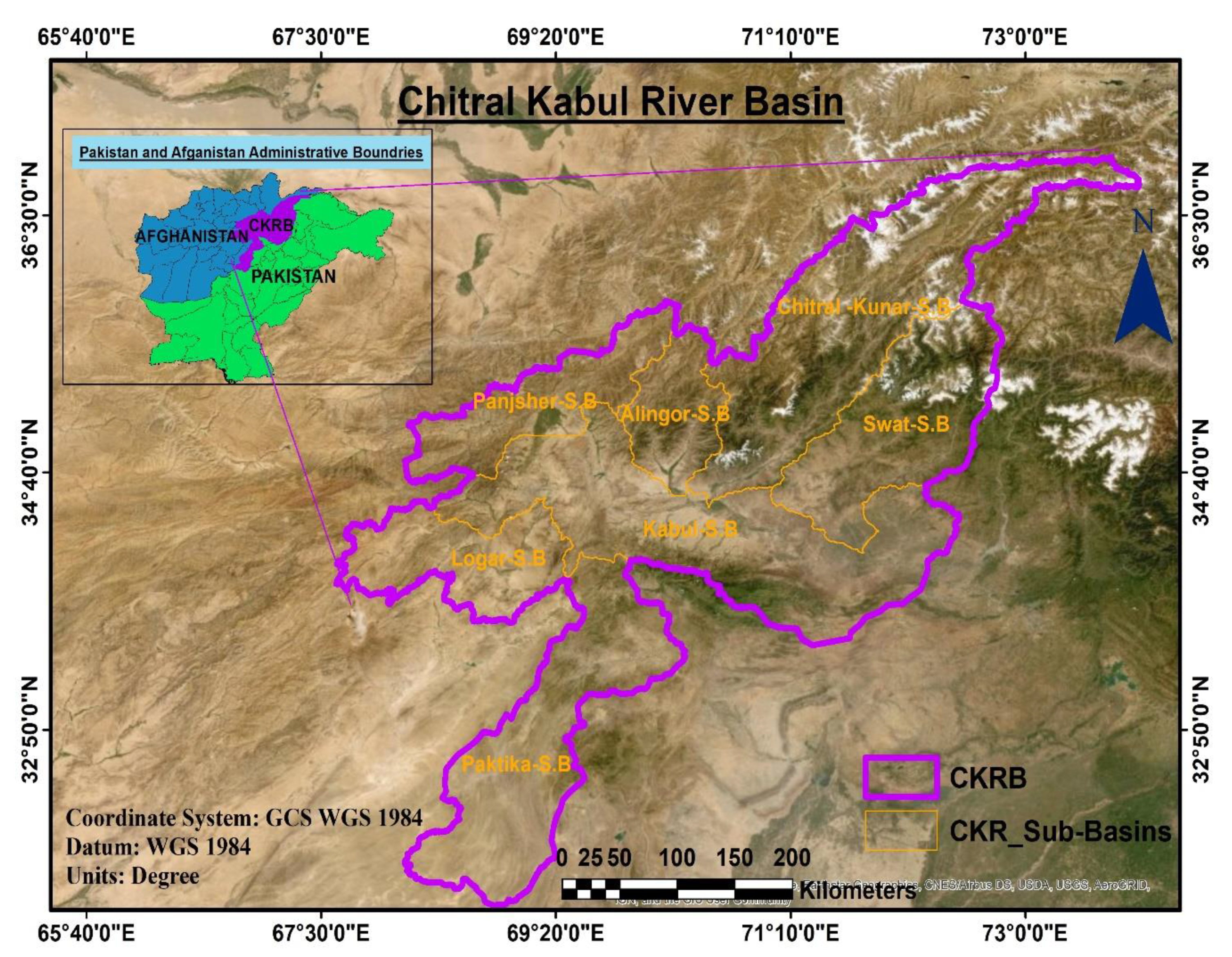
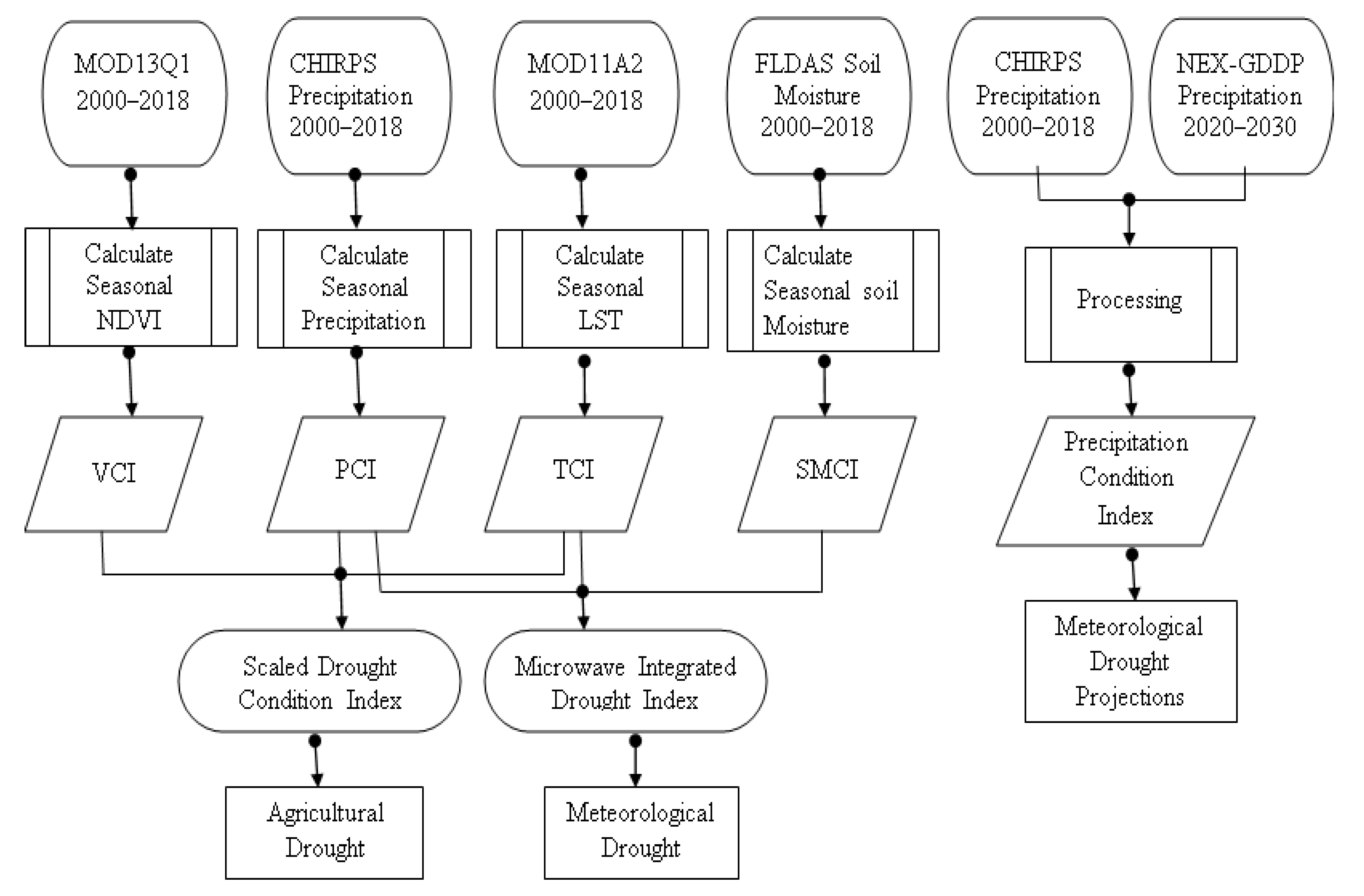
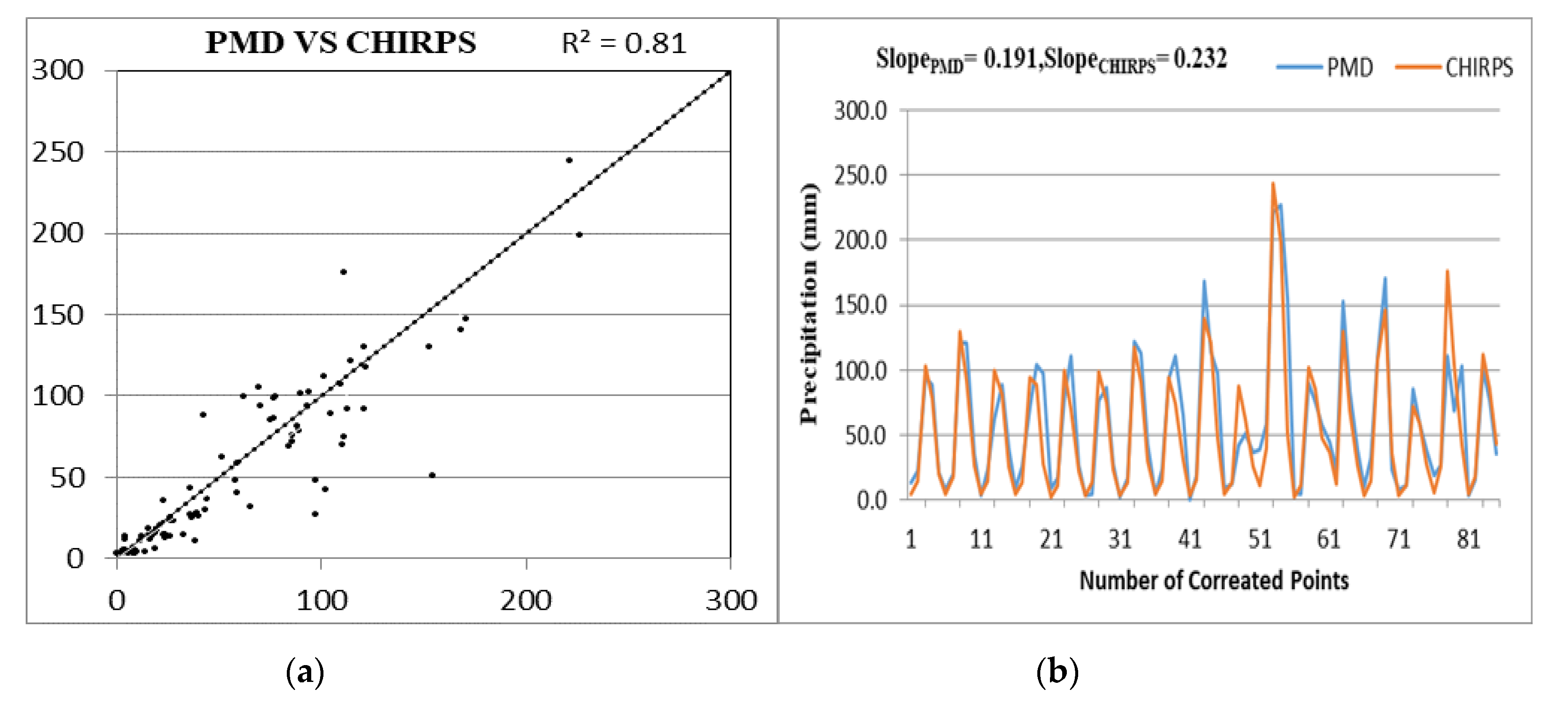
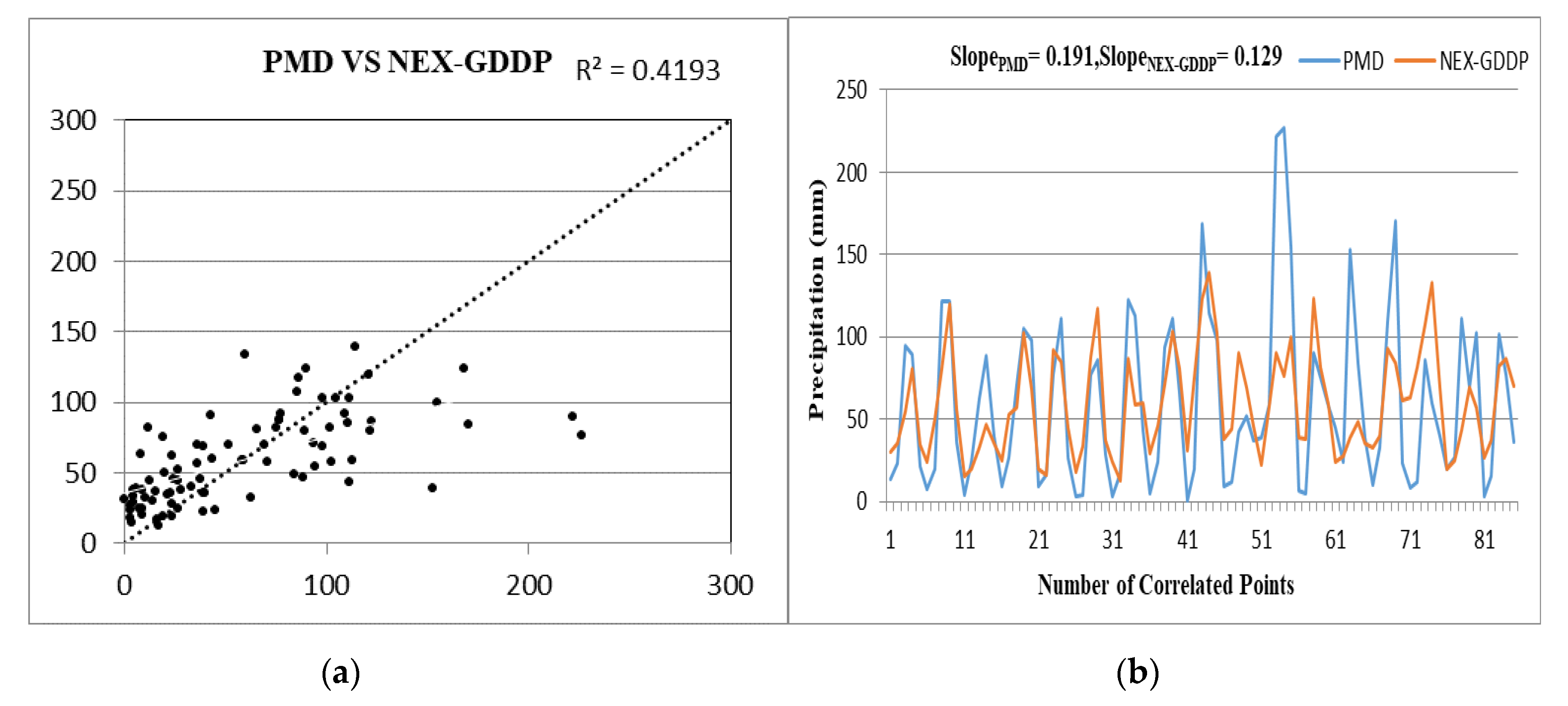
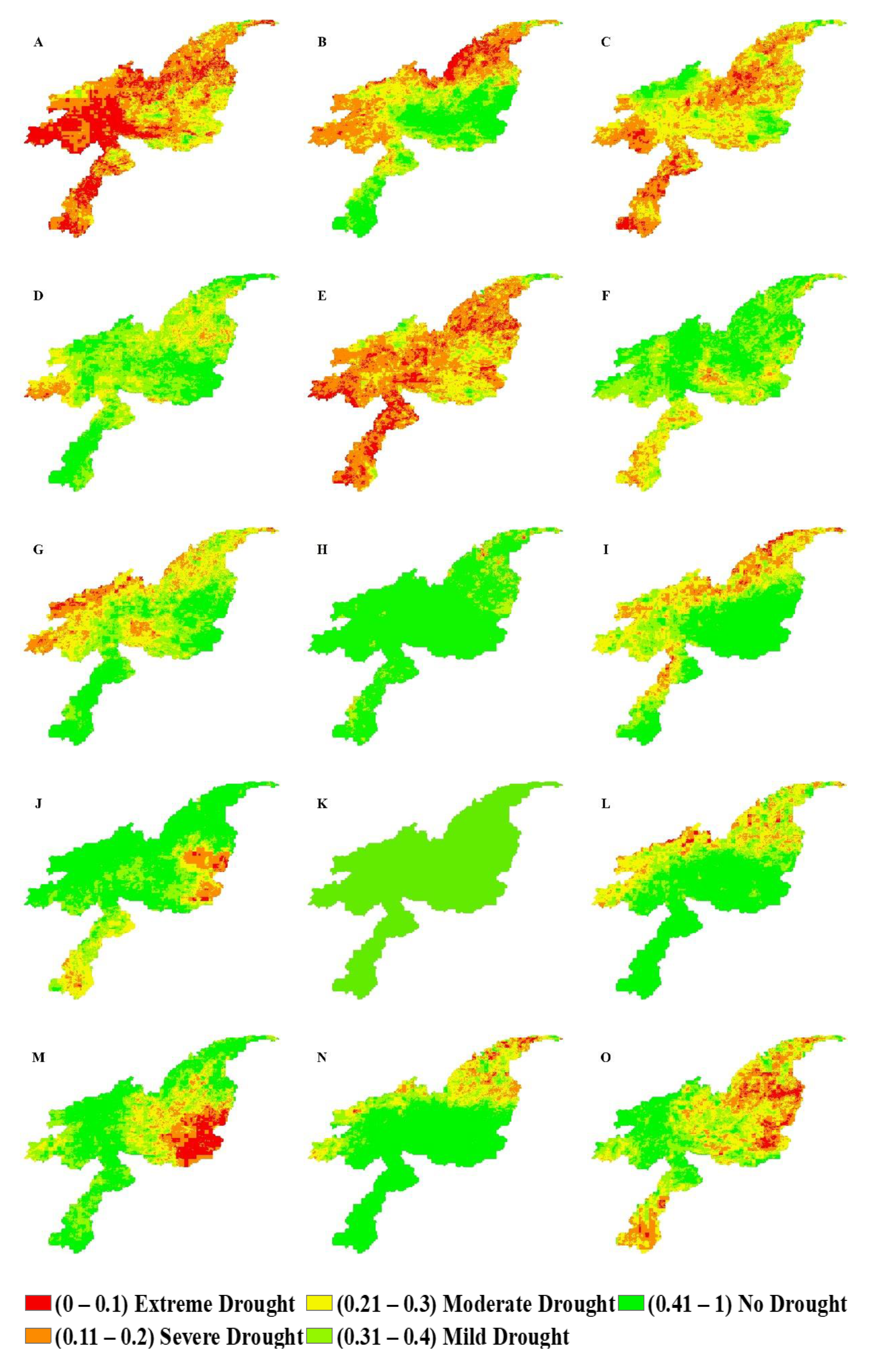
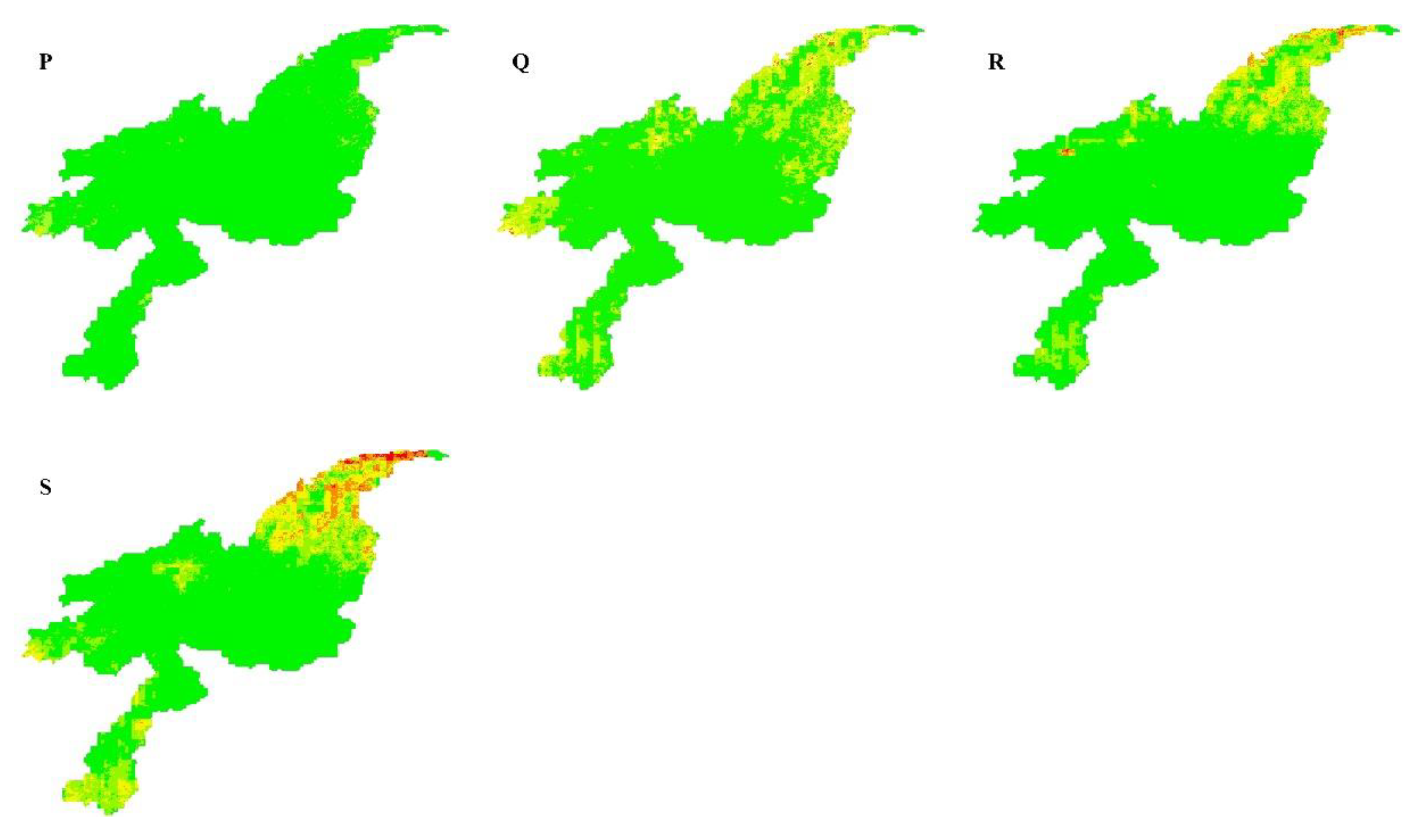

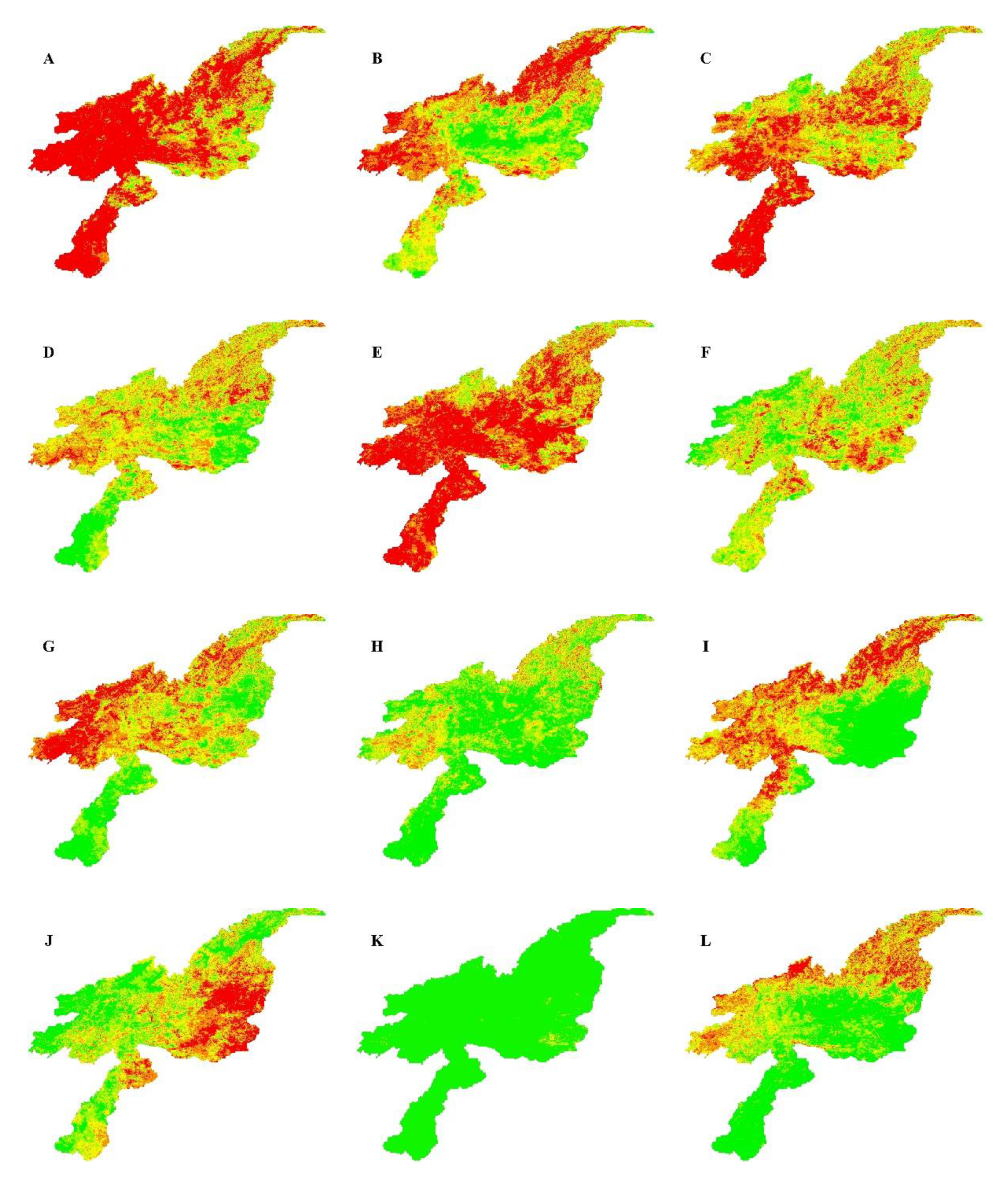



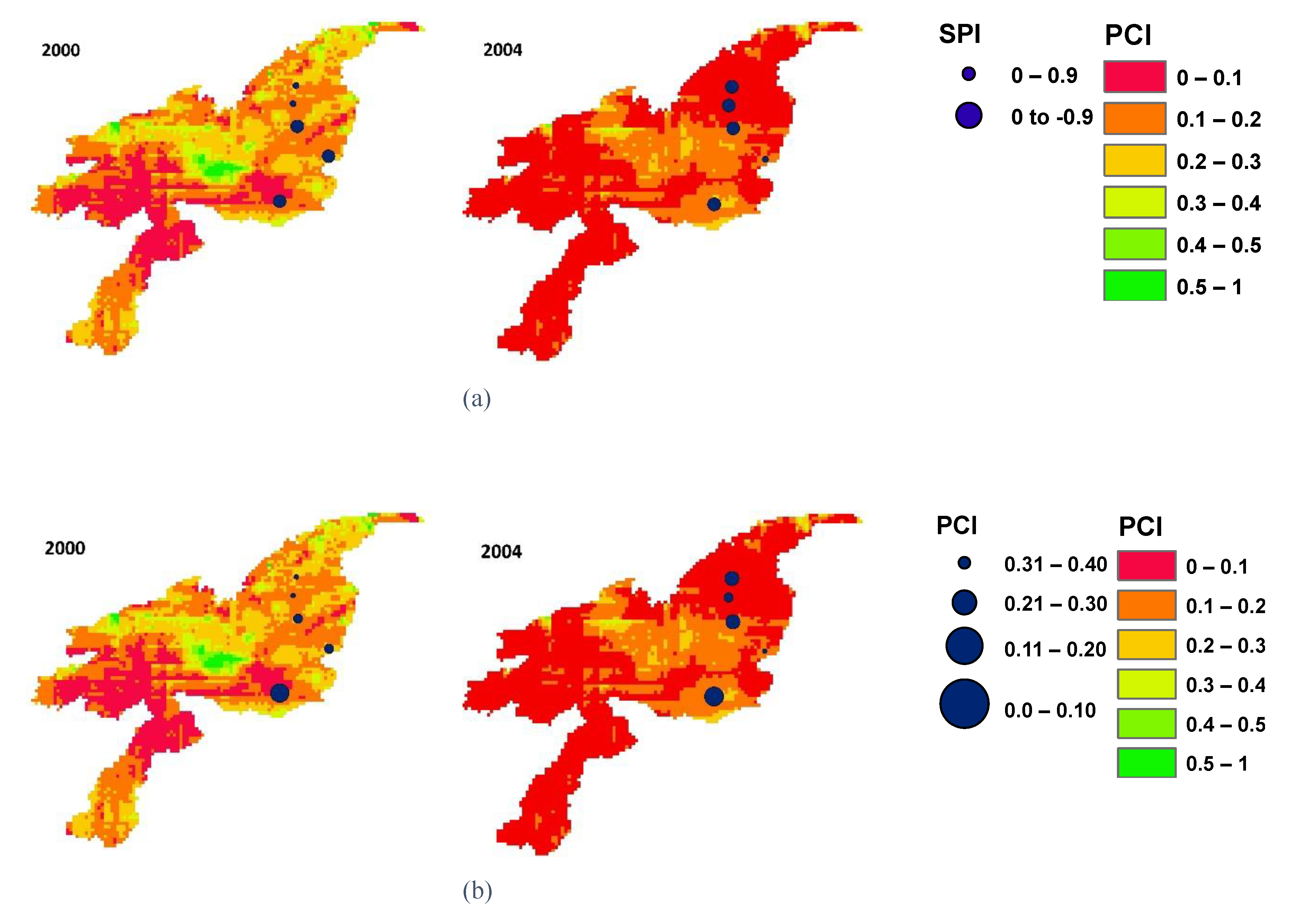
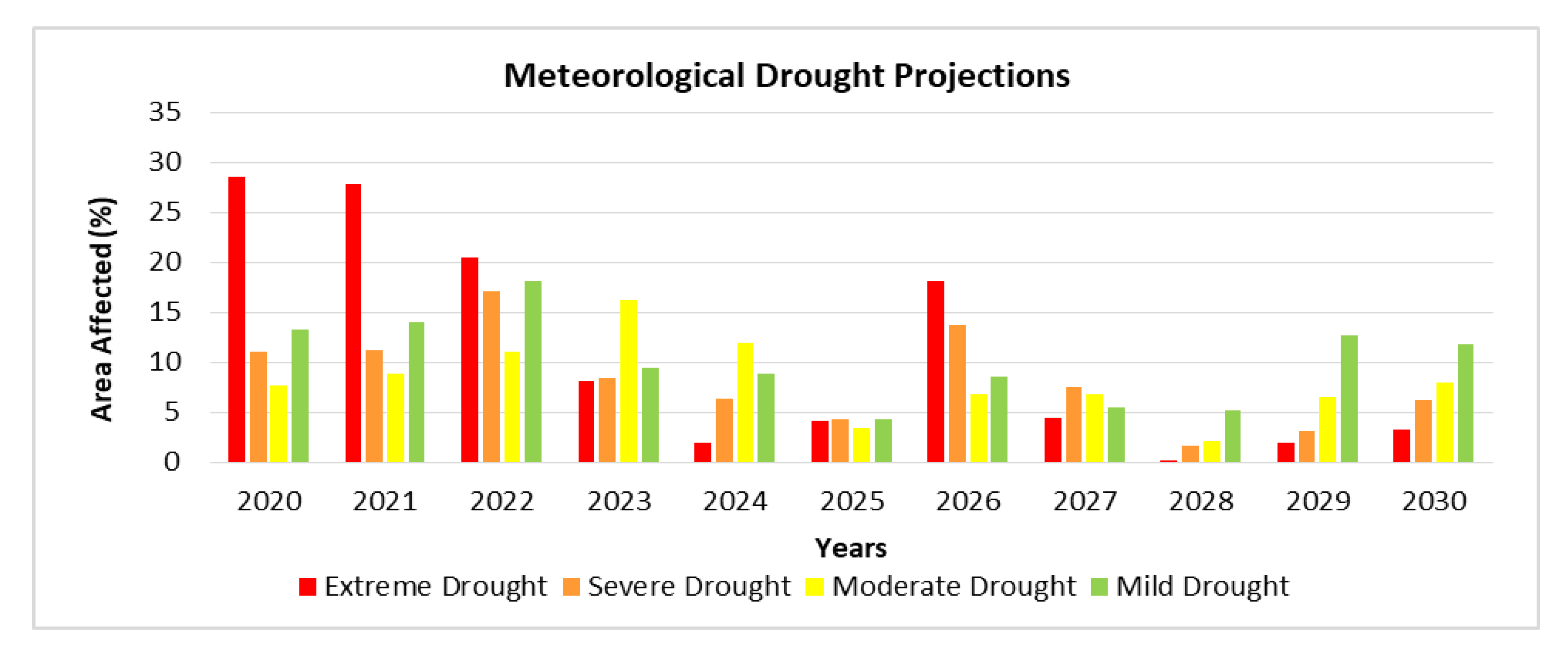
| S. No. | Data | Source | Data Utility | S.R | File Format |
|---|---|---|---|---|---|
| 1 | Climate Hazards Group Infra-Red Precipitation with Station data (CHIRPS) | http://chg.geog.ucsb.edu/data/chirps/ | Precipitation Condition Index (PCI) | 0.05° | Geo tiff |
| 2 | MODIS Land Surface Temperature (LST), (MOD11A2) | MODIS packages in R Console. | Temperature Condition Index (TCI) | 1 km | Geo tiff |
| 3 | Normalized Difference Vegetation Index (MOD13Q1) | MODIS packages inn R Console. | Vegetation Condition Index (VCI) | 250 m | Geo tiff |
| 4 | Monthly Soil moisture (in soil layer depth of 0–10 cm, 10–40 cm and 40–100 cm) | FLDAS_NOAH01_C_GL_M https://disc.gsfc.nasa.gov/datasets/FLDAS_NOAH01_C_GL_M_V001/summary?keywords=FLDAS | Soil Moisture Condition Index (SMCI) | 1° × 1° | NC file |
| 5 | Precipitation Projections | (NASA) Earth Exchange Global Daily Downscaled Projections (NEX-GDDP) https://cds.nccs.nasa.gov/nex-gddp/. | Precipitation Condition Index (PCI) | 0.25° | NC file |
| Drought Index | Formula | Source |
|---|---|---|
| Vegetation Condition Index (VCI) | (Kogan, 1995) [22] | |
| Temperature Condition Index (TCI) | (Du et al., 2013) [43] | |
| Soil Moisture Condition Index (SMCI) | (Hao et al., 2015) [44] | |
| Precipitation Condition Index (PCI) | (Jiao et al., 2019) [27] | |
| Scaled Drought Condition Index (SDCI) | (Rhee et al., 2010) [29] | |
| Microwave Integrated Drought Index (MIDI) | (Zhang and Jia, 2013) [26] | |
| Non-Microwave Integrated Drought Index (NMIDI) | (Baig et al., this paper) |
© 2020 by the authors. Licensee MDPI, Basel, Switzerland. This article is an open access article distributed under the terms and conditions of the Creative Commons Attribution (CC BY) license (http://creativecommons.org/licenses/by/4.0/).
Share and Cite
Baig, M.H.A.; Abid, M.; Khan, M.R.; Jiao, W.; Amin, M.; Adnan, S. Assessing Meteorological and Agricultural Drought in Chitral Kabul River Basin Using Multiple Drought Indices. Remote Sens. 2020, 12, 1417. https://doi.org/10.3390/rs12091417
Baig MHA, Abid M, Khan MR, Jiao W, Amin M, Adnan S. Assessing Meteorological and Agricultural Drought in Chitral Kabul River Basin Using Multiple Drought Indices. Remote Sensing. 2020; 12(9):1417. https://doi.org/10.3390/rs12091417
Chicago/Turabian StyleBaig, Muhammad Hasan Ali, Muhammad Abid, Muhammad Roman Khan, Wenzhe Jiao, Muhammad Amin, and Shahzada Adnan. 2020. "Assessing Meteorological and Agricultural Drought in Chitral Kabul River Basin Using Multiple Drought Indices" Remote Sensing 12, no. 9: 1417. https://doi.org/10.3390/rs12091417
APA StyleBaig, M. H. A., Abid, M., Khan, M. R., Jiao, W., Amin, M., & Adnan, S. (2020). Assessing Meteorological and Agricultural Drought in Chitral Kabul River Basin Using Multiple Drought Indices. Remote Sensing, 12(9), 1417. https://doi.org/10.3390/rs12091417





